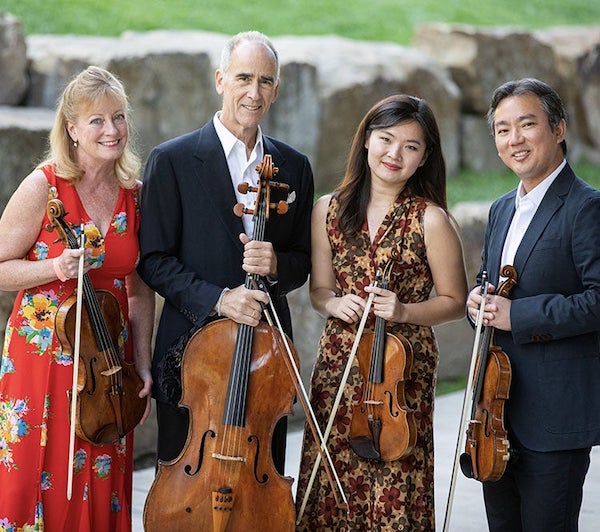New York Philharmonic Quartet serves up a season highlight for FOCM

The New York Philharmonic String Quartet performed Monday night at Coral Gables Congregational Church.
A new stage at the Coral Gables Congregational United Church of Christ greeted the New York Philharmonic String Quartet’s annual performance for Friends of Chamber Music on Monday night.
The recently installed flooring on the sanctuary’s main platform proved an acoustical boon with the sound clear, full and transparent. But, renovations aside, it was the group’s outstanding music-making that really made the event special.
Mozart’s Quartet No. 19 in C Major (“Dissonance”) is one of the Salzburg’s genius’s most profound chamber works and the players’ reading emphasized the drama and pathos beneath the music’s surface gleam. Following a restrained slow introduction, the quartet launched into a taut, no-nonsense traversal of the main Allegro. Violinist Frank Huang’s lithe articulation and strong leadership aided in projecting the score’s underlying gravitas.
Each of the orchestra’s four first-chair string players displays a distinctive sonority but their skillful blending and adroit balancing result in unified ensemble playing and well defined interpretive instincts. In a deliberately paced Andante cantabile’s Huang’s shining tone and Carter Brey’s deep-voiced cello were first among equals. There was a touch of the rustic in the Menuetto, aided by bold contrasts of dynamics. The trio section emerged pensive, maintaining constant thrust. Bright and lively, the final Allegro molto was taken at an especially rapid clip but the sudden unexpected dissonances that give the score its subtitle were firmly emphasized.
The classicism of the Mozart was followed by a blast of modernism with Joel Thompson’s In Response to the Madness. Written during the height of the Covid pandemic, this brief single-movement creation runs the gamut from driving rhythms to lyrical interludes and fugal moments mixed with suggestions of minimalism. Thompson’s eclectic work seemed more a series of grand gestures than a coherent journey, but the conviction of the quartet’s performance highlighted the score’s strong points.
Last season, the Tetzlaff Quartet gave an outstanding performance of Schubert’s Quartet No. 14 in D minor (“Death and the Maiden”). The New York musicians offered an equally distinguished but very different take on this Schubert masterpiece.
They gave a modern, streamlined performance with a strong linear flow. Each instrumental line came through with clarity while there was vivid definition in the interplay of timbres. After the sheer intensity of the opening movement, the coda, played softly, generating a sense of tragedy. In the second movement Andante con moto, each of the variations on the Schubert lieder that gives the quartet its subtitle was given specific character. The burnished mahogany of Cynthia Phelps’ viola was a constant presence while Brey’s control and subtlety embellished the fervor of Schubert’s amazing variety of expression.
The Scherzo avoided Viennese sweetness in favor of a vital, at times harsh and rambunctious energy. That momentum carried over into the final Presto, given incisive motoric speed. Second violin Qianqian Li’s shining sound took special honors. The second theme became a large, emphatic statement rather than a lighter interlude. The exhilarating brilliance of this freshly conceived performance continued through the final bars of the whirlwind coda.
All three performances were applauded and cheered with unusual enthusiasm by an appreciative audience.
Friends of Chamber Music presents the Hermitage Piano Trio playing Rachmaninoff’s Trio elegiaque No. 1, Shostakovich’s Piano Trio No. 2 and Mendelssohn’s Piano Trio in C minor 8 p.m. February 21 at Coral Gables Congregational United Church of Christ. miamichambermusic.org
Posted in Performances
Leave a Comment
Tue Feb 14, 2023
at 12:53 pm
No Comments
